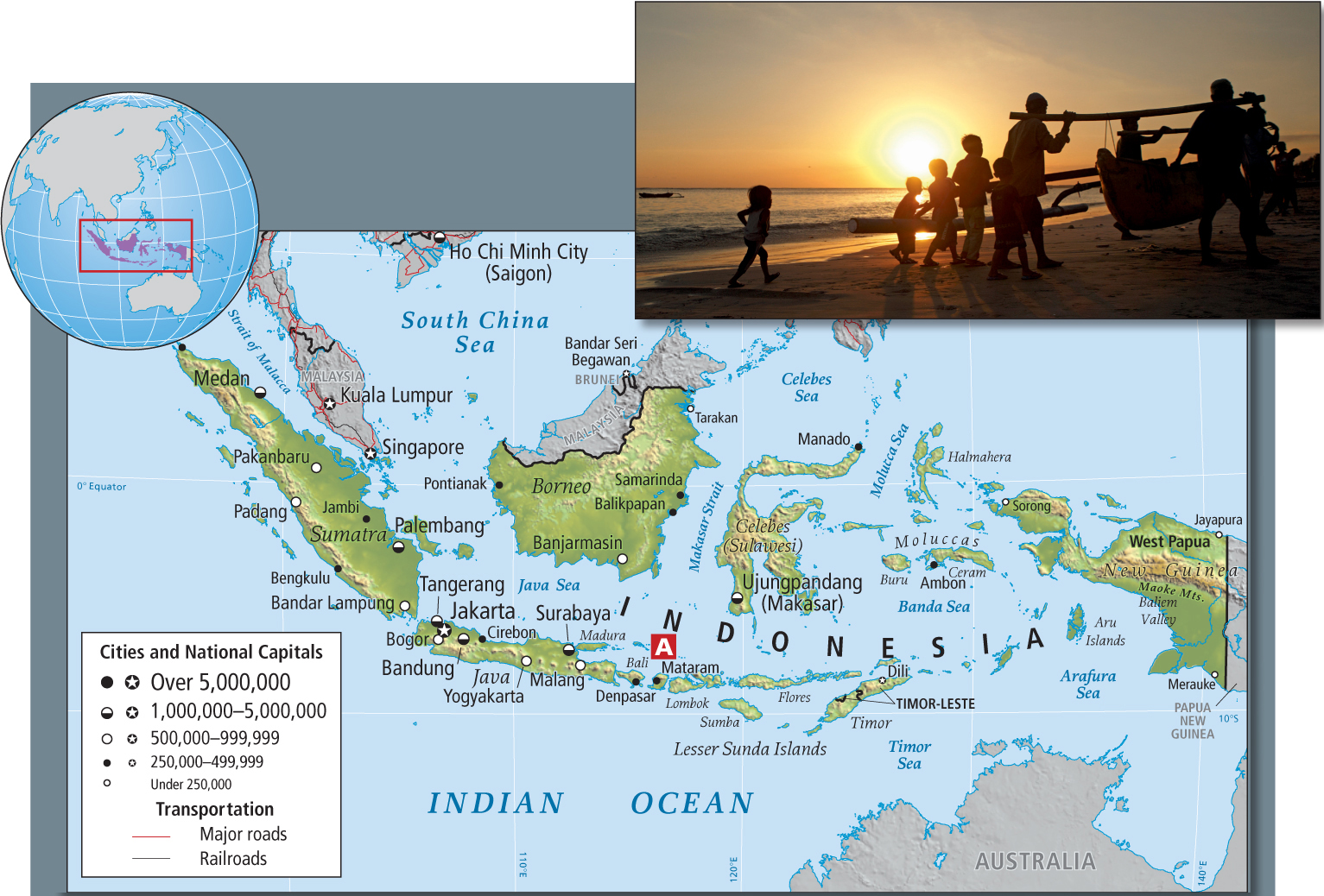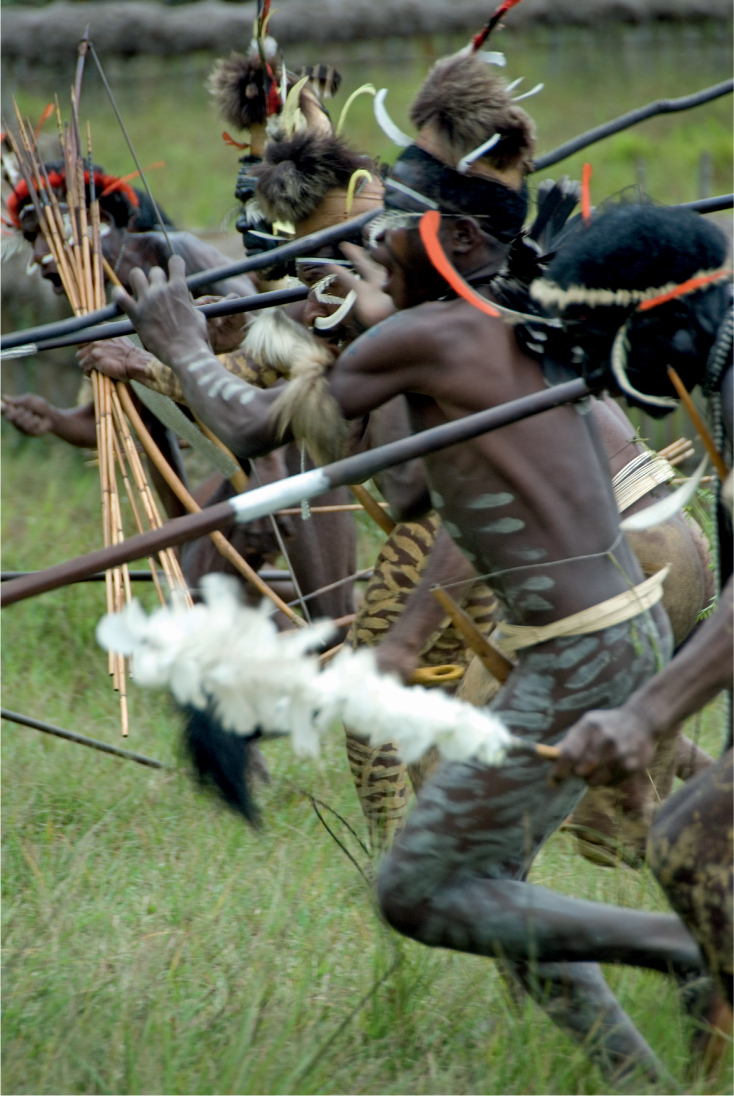Indonesia and Timor-Leste
Indonesia, with the world’s largest Muslim population, is a recent amalgamation of island groups, inhabited by people who, before the colonial era, never thought of themselves as a national unit (Figure 10.33 map). Rivalry between island peoples remains strong, and many resent the dominance of the Javanese in government and business. This resentment and other burgeoning issues of identity and allegiance are serious threats to Indonesia’s continued unity (see the discussion of Indonesia that begins with “Can Democracy Work in Indonesia?”). Emblematic of the fragile state of this subregion is the fact that Timor-Leste, the eastern half of the small island of Timor, is now independent. In 1999, after more than 20 years of armed conflict with Indonesia, in which the infrastructure was destroyed and as many as 250,000 people died (one-quarter of the population), the people of eastern Timor voted in a UN plebiscite to split from Indonesia and become Timor-Leste. For 2 more years, the Indonesian military tried to enforce cohesion, in part because of Timor-Leste’s oil and gas deposits, but in 2002, after 1500 more deaths, Timor-Leste became an independent country.

The archipelago of Indonesia consists of the large islands of Sumatra, Java, and Sulawesi; the Lesser Sunda Islands east of Java (including Bali; see Figure 10.33A); Kalimantan, which shares the island of Borneo with Malaysia and Brunei; West Papua on the western half of New Guinea; and the Moluccas. In all, it contains some 17,000 islands, but some are small, uninhabited bits of coral reef. The term Indonesia was coined in 1850 by James Logan, a Singapore-residing Englishman, from two Greek words: indos (Indian) and nesoi (islands). Indonesians themselves now refer to the archipelago as Tanah Air Kita, meaning “Our Land and Water.” This name conveys a sense of the archipelago environment, but falsely indicates a universal feeling of togetherness and environmental concern.
The island of Java, the most economically productive in Indonesia, is home to 60 percent of the country’s population (238 million people in 2011), but only 7 percent of its available land. However, thousands of years of ash from Java’s 17 volcanoes have made the soil rich and productive, capable of supporting large numbers of people. Another 21 percent of the population lives on the adjacent volcanic island of Sumatra. Recently, nearly 3 million people were resettled from Java to Sumatra, most under a reinstituted government resettlement policy.
The resettlement of Javanese people to other islands in Indonesia has been a contentious issue because indigenous people resent being inundated with Javanese culture and concepts of economic development. They see resettlement as a Javanese effort to gain access to, and profit from, indigenously held natural resources, such as oil, precious metals, and forestlands. Indigenous people, some of whom continue to live via subsistence agriculture as they have for millennia (Figure 10.34), have been repeatedly devastated by the rapid changes brought to everyday life by the newcomers. The government’s argument that resettlement provides jobs is true, strictly speaking. But often the habitat is degraded beyond repair. The central government tends to ignore these hardships, instead invoking the principles of Pancasila, arguing that resettlement strengthens Indonesian identity by spreading modernization and eliminating ways of life that differ from the government’s vision of the norm.

THINGS TO REMEMBER
 Indonesia is densely settled and has the world’s fourth-largest population. It also has the world’s largest Muslim population.
Indonesia is densely settled and has the world’s fourth-largest population. It also has the world’s largest Muslim population. Timor-Leste, rich in oil and gas deposits, yet with many impoverished residents, gained its independence from Indonesia in 2002.
Timor-Leste, rich in oil and gas deposits, yet with many impoverished residents, gained its independence from Indonesia in 2002. Indonesia is a country made up of numerous islands that are home to many ethnic groups. Now bound into one unit, it has had to construct a national identity.
Indonesia is a country made up of numerous islands that are home to many ethnic groups. Now bound into one unit, it has had to construct a national identity. A contentious strategy for resolving the country’s population and unemployment problems has been resettlement of urban populations to deforested lands, displacing indigenous peoples.
A contentious strategy for resolving the country’s population and unemployment problems has been resettlement of urban populations to deforested lands, displacing indigenous peoples.